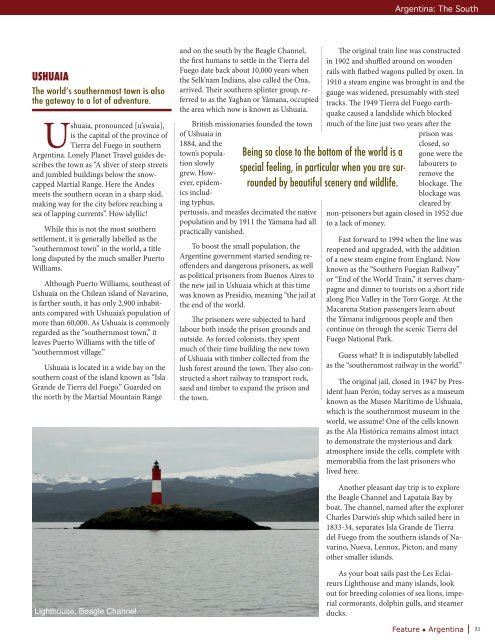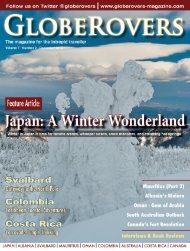Globerovers Magazine, July 2019
GLOBEROVERS MAGAZINE IS NO LONGER ALLOWED TO HAVE MORE THAN 3 ISSUES ON YUMPU UNLESS WE PAY (to provide revenue-generating content to Yumpu!!) SO PLEASE SEE ALL OUR ISSUES FOR FREE ON THESE MAGAZINE PLATFORMS: CALAMEO, MAGZTER, AND ON THE FREE "globerovers" APP. In this 13th issue (July 2019) of Globerovers Magazine, the feature destination is Argentina. We travel from the far north on the border with Bolivia all the way down south to Ushuaia, the gateway to the Antarctic Peninsula. We also have articles about Cyprus and Mauritius Island, Australia, Canada, and we enjoy a colourful New Year Festival with the Naga people in the remote Nagaland region of Myanmar. Photo Essays include the proboscis monkeys and orangutans in Malaysia’s Sabah State on Borneo Island, Peru’s Sacred Valley, and a boat trip down the Li River from Guilin to Yangshuo in China. Furthermore, we have traveller interviews, book reviews, and a lot more! Feedback to editor@globerovers.com. Enjoy!
GLOBEROVERS MAGAZINE IS NO LONGER ALLOWED TO HAVE MORE THAN 3 ISSUES ON YUMPU UNLESS WE PAY (to provide revenue-generating content to Yumpu!!) SO PLEASE SEE ALL OUR ISSUES FOR FREE ON THESE MAGAZINE PLATFORMS: CALAMEO, MAGZTER, AND ON THE FREE "globerovers" APP.
In this 13th issue (July 2019) of Globerovers Magazine, the feature destination is Argentina. We travel from the far north on the border with Bolivia all the way down south to Ushuaia, the gateway to the Antarctic Peninsula.
We also have articles about Cyprus and Mauritius Island, Australia, Canada, and we enjoy a colourful New Year Festival with the Naga people in the remote Nagaland region of Myanmar.
Photo Essays include the proboscis monkeys and orangutans in Malaysia’s Sabah State on Borneo Island, Peru’s Sacred Valley, and a boat trip down the Li River from Guilin to Yangshuo in China.
Furthermore, we have traveller interviews, book reviews, and a lot more!
Feedback to editor@globerovers.com. Enjoy!
You also want an ePaper? Increase the reach of your titles
YUMPU automatically turns print PDFs into web optimized ePapers that Google loves.
Argentina: The South<br />
USHUAIA<br />
The world’s southernmost town is also<br />
the gateway to a lot of adventure.<br />
Ushuaia, pronounced [u’swaia],<br />
is the capital of the province of<br />
Tierra del Fuego in southern<br />
Argentina. Lonely Planet Travel guides describes<br />
the town as “A sliver of steep streets<br />
and jumbled buildings below the snowcapped<br />
Martial Range. Here the Andes<br />
meets the southern ocean in a sharp skid,<br />
making way for the city before reaching a<br />
sea of lapping currents”. How idyllic!<br />
While this is not the most southern<br />
settlement, it is generally labelled as the<br />
“southernmost town” in the world, a title<br />
long disputed by the much smaller Puerto<br />
Williams.<br />
Although Puerto Williams, southeast of<br />
Ushuaia on the Chilean island of Navarino,<br />
is farther south, it has only 2,900 inhabitants<br />
compared with Ushuaia’s population of<br />
more than 60,000. As Ushuaia is commonly<br />
regarded as the “southernmost town,” it<br />
leaves Puerto Williams with the title of<br />
“southernmost village.”<br />
Ushuaia is located in a wide bay on the<br />
southern coast of the island known as “Isla<br />
Grande de Tierra del Fuego.” Guarded on<br />
the north by the Martial Mountain Range<br />
and on the south by the Beagle Channel,<br />
the first humans to settle in the Tierra del<br />
Fuego date back about 10,000 years when<br />
the Selk’nam Indians, also called the Ona,<br />
arrived. Their southern splinter group, referred<br />
to as the Yaghan or Yámana, occupied<br />
the area which now is known as Ushuaia.<br />
British missionaries founded the town<br />
of Ushuaia in<br />
1884, and the<br />
town’s population<br />
slowly<br />
grew. However,<br />
epidemics<br />
including<br />
typhus,<br />
pertussis, and measles decimated the native<br />
population and by 1911 the Yámana had all<br />
practically vanished.<br />
The original train line was constructed<br />
in 1902 and shuffled around on wooden<br />
rails with flatbed wagons pulled by oxen. In<br />
1910 a steam engine was brought in and the<br />
gauge was widened, presumably with steel<br />
tracks. The 1949 Tierra del Fuego earthquake<br />
caused a landslide which blocked<br />
much of the line just two years after the<br />
prison was<br />
closed, so<br />
gone were the<br />
labourers to<br />
remove the<br />
blockage. The<br />
blockage was<br />
cleared by<br />
non-prisoners but again closed in 1952 due<br />
to a lack of money.<br />
Being so close to the bottom of the world is a<br />
special feeling, in particular when you are surrounded<br />
by beautiful scenery and wildlife.<br />
To boost the small population, the<br />
Argentine government started sending reoffenders<br />
and dangerous prisoners, as well<br />
as political prisoners from Buenos Aires to<br />
the new jail in Ushuaia which at this time<br />
was known as Presidio, meaning “the jail at<br />
the end of the world.<br />
The prisoners were subjected to hard<br />
labour both inside the prison grounds and<br />
outside. As forced colonists, they spent<br />
much of their time building the new town<br />
of Ushuaia with timber collected from the<br />
lush forest around the town. They also constructed<br />
a short railway to transport rock,<br />
sand and timber to expand the prison and<br />
the town.<br />
Fast forward to 1994 when the line was<br />
reopened and upgraded, with the addition<br />
of a new steam engine from England. Now<br />
known as the “Southern Fuegian Railway”<br />
or “End of the World Train,” it serves champagne<br />
and dinner to tourists on a short ride<br />
along Pico Valley in the Toro Gorge. At the<br />
Macarena Station passengers learn about<br />
the Yámana indigenous people and then<br />
continue on through the scenic Tierra del<br />
Fuego National Park.<br />
Guess what? It is indisputably labelled<br />
as the “southernmost railway in the world.”<br />
The original jail, closed in 1947 by President<br />
Juan Perón, today serves as a museum<br />
known as the Museo Marítimo de Ushuaia,<br />
which is the southernmost museum in the<br />
world, we assume! One of the cells known<br />
as the Ala Histórica remains almost intact<br />
to demonstrate the mysterious and dark<br />
atmosphere inside the cells, complete with<br />
memorabilia from the last prisoners who<br />
lived here.<br />
Another pleasant day trip is to explore<br />
the Beagle Channel and Lapataia Bay by<br />
boat. The channel, named after the explorer<br />
Charles Darwin’s ship which sailed here in<br />
1833-34, separates Isla Grande de Tierra<br />
del Fuego from the southern islands of Navarino,<br />
Nueva, Lennox, Picton, and many<br />
other smaller islands.<br />
Lighthouse, Beagle Channel.<br />
As your boat sails past the Les Eclaireurs<br />
Lighthouse and many islands, look<br />
out for breeding colonies of sea lions, imperial<br />
cormorants, dolphin gulls, and steamer<br />
ducks.<br />
Feature • Argentina | 31





